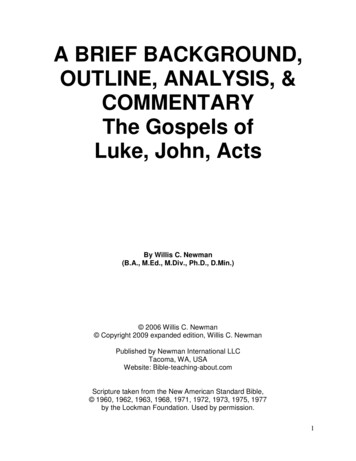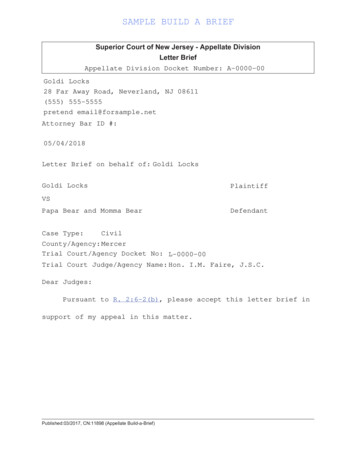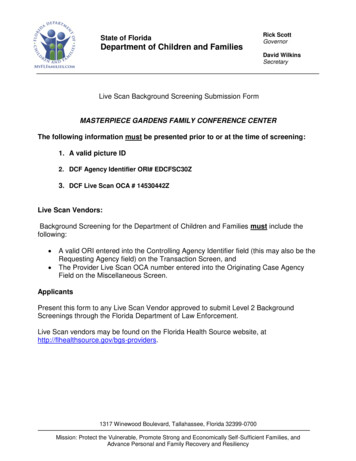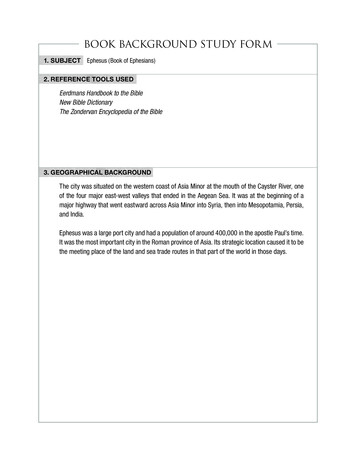
Transcription
A BRIEF BACKGROUND,OUTLINE, ANALYSIS, &COMMENTARYThe Gospels ofLuke, John, ActsBy Willis C. Newman(B.A., M.Ed., M.Div., Ph.D., D.Min.) 2006 Willis C. Newman Copyright 2009 expanded edition, Willis C. NewmanPublished by Newman International LLCTacoma, WA, USAWebsite: Bible-teaching-about.comScripture taken from the New American Standard Bible, 1960, 1962, 1963, 1968, 1971, 1972, 1973, 1975, 1977by the Lockman Foundation. Used by permission.1
INTRODUCTIONThis work is not meant to be exhaustive in scope, but to introduce you, the student, to amajor overview of the Gospels of Luke and John plus the Acts of the Apostles. Thesenotes are the culmination of many years of my teaching New Testament studies, but astime rolls on, and the Lord permits, I will add more information. Here you get the basics.This work is written in outline form. The reason being I first put them down in lectureform, and have kept up the pattern. Since I am still teaching, and this is an onlinecourse, I trust the format is still useful to you.This work is organized in three major sections. First, I cover the introductory issues ofthe Gospel of Luke, and second and third, I do the same thing with John and Acts. Fordetails on an introduction to the four Gospels, I recommend my commentary on theintroduction to the Gospels, Matthew, and Mark. There I cover an overview of theGospels that includes the nature and critical issues of the Gospels along with a briefpresentation of the cultural and historical context. In addition, more details onbackground material can be found in my New Testament Survey work.You will find a general bibliography for the entire New Testament at the back. I alsoinclude several online sources that are invaluable for you who are taking this courseonline.The following table of contents will give you greater detail in following the material, andlocating various subjects with comments. I give the page numbers of the outlines ofeach book that will break down in greater detail the organization of the material, andhow to find comment on various subjects.One magnificent product of the computer age is being able to put this work in pdfformat. You can use this tool as an index. Just type in the word you are looking for, andAdobe will find them for you.I wish you all the best as you undertake this study about the wonderful life of ourwonderful Savior and Lord, Jesus Christ.Dr. Willis C. NewmanTacoma, Washington, 20092
About the AuthorI am reluctant to talk about myself, but I must to establish a degree of credibility. I alsoplace this here so you can get a little acquainted with me. I received my B.A. inPsychology and M.Ed. in counseling from the University of Portland. I earned the M.Div.from Western Conservative Baptist Seminary (pastoral studies), the Ph.D. in churchadministration from California Graduate School of Theology, and the D.Min. in crosscultural studies from Faith Evangelical Seminary (Tacoma).I also have taken other courses, and obtained certificates. For example, I have the“Grad Certificate” in Bible from Multnomah Bible College (Portland, Oregon), and acertificate in fund raising management from the University of Washington.I grew up in central Idaho on a cattle ranch. In my youth I was a cowboy, sawmillworker, construction worker, and did other labor type work. I have three living children:Willie, Teri, and Matthew, who I just adopted. Matt is the son of my Filipina wife,Esmeralda. We have been married almost 10 years. I have six grandchildren, and onegreat granddaughter.I served eight years as a pastor, and seven years as a missionary to the Kingdom ofTonga where I established Faith Seminary - Tonga. I have taught at the college orgraduate school level for over 20 years at such places as International College &Graduate School of Theology (Hawaii), Faith Evangelical Seminary (Tacoma), and atthe community college level in America. I have taught as guest lecturer in the SouthPacific for International School of Theology (Manila).I am an Adjunct Assistant Professor at a community college, and a Professor at FaithEvangelical Seminary. My favorite music is American Country and Western, HawaiianSlack guitar, blues, and Jazz. My favorite sports are boxing, rodeo, and Americanprofessional football. This may sound corny, but the book that has influenced me themost is the Christian Bible.All the best to you my friend as you study the wonderful word of God through the Bible.You will do well. Stay encouraged in the work of Christ.Dr. Willis Newman, 20093
TABLE OF CONTENTSBackground, commentary,outline & analysisof Luke, John, ActsThe Gospel of LukeBrief Context of the Gospel of Luke.Background information .The author .Date and place of writing .Theme and purpose .Target readership .The distinctiveness of Luke‟s GospelNoteworthy observations and emphasis .Samples of Christ‟s teaching in Luke.Brief outline of Luke .8888999101111Analysis, comments, practical notesThe preparation of Jesus Christ .14Introduction to the book.14Childhood of John and Jesus.14Ministry of Jesus Christ in Galilee .15Jesus‟ temptation .15Jesus introduced His ministry.15Jesus demonstrated His authority and power .16Jesus selected His disciples.17Jesus was active in ministry.17Ministry in Judea and Perea.18-20Rejected by Samaritans, men of the world, commissioned the 70Explained true religion, taught Mary and Martha, taught disciples to pray,Rejection by many, Jewish leaders, Hypocrisy, greed, faithfulness,Divisions and signs.Jesus‟ teachings: repentance, hypocrisy, kingdom, different kinds of people21-23Soul-winning, Prodical son, wealth.Jesus taught about hell.24Various principles of life .26Jesus‟ week of passion.28Jesus‟ triumphal entry into Jerusalem.28Jesus wept over Jerusalem‟s destruction.29Jesus cast out the temple money changers.29Day three: confrontation and teaching .30The second coming of Christ.31The betrayal by Judas: day four .32Day five: Thursday .324
Day six: Friday.Day seven: Saturday.The resurrection and ascension of ChristThe empty tomb, Emmaus disciplesThe resurrected body and life.The Great Commission.The ascension of Christ.The Herod family .Who was Theophilus?.Timeline of Paul‟s ministry .33353636363637Extended 616262626364656667676869The Gospel of JohnBackground information .The writer.The purpose and theme .Date and place of writing; readership and contextSeven sign miracles of John.Noteworthy observations .Christ‟s Deity emphasized .Christ‟s claims to Deity.Eternal life .Brief outline of John .The Gospel of John: analysis, outline, commentsIntroduction: the Person of Christ .Twelve great truths about Jesus Christ .Christ is the Logos (Word) .Christ eternally co-existent with God the Father.Witnesses to the Person of Christ .Witness of John the Baptist.Witness of Jesus‟ disciples .Ten great titles given to Jesus in chapter one .Witness of Jesus .The public ministry of Christ.Christ cleansed the temple .Christ witnessed to Nicodemus .We must be born again: Jesus.Faith alone for salvation .John the Baptist gave testimony .Jesus led the Samaritan woman to salvation .Jesus healed the official‟s son.Jesus: the author and sustainer of life .The bread of life.The seven great I Am‟s.5
Jesus was opposed by others.Jesus and the woman taken in adultery .Jesus the spiritual light of the world.Jesus as the Good Shepherd.Lazarus raised from the dead.Jesus ministered in private to His own .Last supper, encouragement, fruit bearing, Holy Spirit, prayerJesus suffered and died .Arrested, before Annas, Caiaphas, Pilate, crucifixion, burialJesus rose from the dead .Empty tomb, Mary Magdalene, disciples, Thomas, the seven disciples,On backsliding6970727274787980The Acts of the ApostlesBackground contextBackground and introduction.The author .The purpose of the book .The date and setting.General & prominent features.Special importance of Acts .Sequence of major events linked to time .The book of Acts outlined .8383848485858687Analysis and commentsThe Gospel in Jerusalem .89Ministry of Jesus on earth .89The Great Commission, between death and resurrection, ascensionMatthias, the replacement of Judas, Day of Pentecost .92Baptized in the Holy Spirit .93Speaking in tongues.95Second work of grace, the Holy Spirit in salvation.95Repentance, water baptism, obedience and salvation .96Joel‟s prophecy.97Impact of Pentecost, miracle healing, Peter‟s sermon on repentance99First persecution, Ananias & Sapphira, second persecution .99Problems of church growth, first deacons.100Murder of Stephen, regarding death.102The church in Judea & Samaria .104The church scattered by persecution, Philip.104Conversion of Paul .106Peter prepared to evangelize the Gentiles.106The Gospel to the utmost parts of the world.107Start of the church at Antioch.107Christians persecuted by Herod .1086
The first missionary journey by Paul.The Jerusalem council: heresy counteracted .Second missionary journey by Paul.Third missionary journey by Paul .Paul the prisoner for the Gospel .Paul‟s arrest in Jerusalem, defense to the mob, removed to CaesareaPaul‟s defense to Felix, Festus, Agrippa .Paul on to Rome: ocean voyage & shipwreck .Paul‟s ministry of Malta, Rome .Selected bibliography for the New Testament .1091101101131141141161171181197
THE GOSPEL OF LUKE:A BACKGROUND, OUTLINE,ANALYSIS AND COMMENTARYBRIEF CONTEXT OFTHE GOSPEL OF LUKE.In this examination of the Gospel of Luke, my objective is to present a summary ofbackground and introductory issues, point out some general observations, delineate thepurpose, theme, unfolding and outline of the Gospel. We will then give an extendedanalysis of the Gospel along with various comments.I. BACKGROUND INFORMATION.A. THE AUTHOR.The early Christian tradition is unanimous in assigning the authorship of the thirdGospel to Luke. He was a Greek speaking, educated medical doctor (Colossians 4:1214). He possibly was born in Antioch of Syria, and practiced medicine in Philippi. Hewas not an eyewitness to the ministry of Christ. He probably was converted in Antiochby those who fled Jerusalem following the early persecution of Christians by King HerodAgrippa I. Perhaps Paul brought Luke to Christ. Luke did public, itinerant missionarywork, and was one who answered the Macedonian call (Acts 16:13, 17).His ethnicity was Greek, and he was a friend and companion with Paul (Acts 16:10-17;20:5-15; 21:1-18; 27:1-28:16). Paul identified Luke as being distinct from Jews(Colossians 4:11). Luke accompanied Paul on part of his missionary journeys. Heaccompanied Paul to Rome and remained with him during Paul‟s first imprisonment.Many think Luke wrote both his Gospel and Acts during this time. During Paul‟s secondimprisonment, Luke was his only companion, showing great devotion to the Apostle (2Timothy 4:11).Luke later adopted Philippi as his headquarters, and help establish the church therewhile Paul traveled to Corinth during the second missionary journey (Acts 16:40). Verylittle more is known of Luke. An anti-Marcionite prologue to Luke‟s Gospel claims thathe remained without family and died at the age of 84 in Boeatia, Greece. He is theauthor of this Gospel and The Acts of the Apostles. Luke was the first great churchhistorian and literary apologist for Christianity (Luke 1:1-4).B. DATE AND PLACE OF WRITING.The date of writing was about A.D. 60, as Paul went to prison in Rome the first time inA.D. 60. It was before A.D. 70, as that was the year of Jerusalem‟s destruction. Luke8
would have mentioned such a momentous event, but he only gave the account of Jesuspredicting the event (Luke 19:41-44; 21:20-24). The book of Acts ends with Paul inprison in Rome, so Luke‟s history goes up to that point, but no further.The location of writing possibly was in Rome. Luke was with Paul when he reachedRome, and there Paul wrote the “Prison Epistles:” Ephesians, Philippians, Colossians(Colossians 4:14), and Philemon (23, 24). Some say the Gospel was written in Achaia,which was a Greek province. Probably it first appeared there. Another view has Lukewriting the Gospel during Paul‟s two year imprisonment in Caesarea (Acts 24:27), whichwould place the date slightly before A.D. 60. This is the view that I hold.C. THEME AND PURPOSE.The Gospel of Luke places attention on Christ, the Son of Man, the Perfect Man, andSavior of the World. The emphasis is that this is the Gospel for the Greek world in awider sense, although it was directed toward someone named, “Theophilus,” whoseidentity is unknown. Some speculate he was a Gentile. The person may have been ofsome rank, as Luke uses the title, “most excellent” (Luke 1:3).The first four chapters point to Jesus as the Messiah, and show a link to the OldTestament. This would suggest the reader was a person closely related to Judaism.However, that part of the world was Hellenized, that is, deeply entrenched in Greekculture and language, which meant the Gospel needed to appeal to the Greeks. Lukewas a Greek, thus, he would have written from a Greek frame of reference.Chapters 1:1-4:13 establish the identity of Christ. In a world with many Greek gods,Luke would need to distinguish Jesus from all others. This he did by establishing Jesusas the God of the Universe. Chapters 4:14-9:50 portray Jesus‟ teachings anddemonstrations of power. Chapters 9:51-19:44 display the contention between Jesusand the Jewish religious leaders. Chapters 19:45-24:53 speak of the final trials of Jesus,and his death, burial, and resurrection.The purpose of the Gospel was to carefully document the events of Christ‟s life, so thatTheophilus, “might know the exact truth about the things you have been taught” (Luke1:4). In other words, the Gospel was a discipleship manual. However, the Gospel alsohas an apologetic flavor, that is, a defense of the Christian Faith, and finally, it had anevangelistic thrust. Paul used a similar pattern of both defending the faith andevangelistic intent with King Herod Agrippa II (e.g. Acts 26:2, 3, 26, 27).D. THE TARGET READERSHIP.The immediate readership of this Gospel is someone by the name of Theophilus. It isalso oriented toward all Gentiles. For an extended examination of this man, see thearticle on, Who is Theophilus? at the end of this commentary on Luke.F. THE DISTINCTIVENESS OF LUKE’S GOSPEL.Each of the Bible books has their own distinctive flavor. This is determined by thepurpose of the book (or letter), the historical, cultural, geographic conditions of the time9
the readership, and the unique background and abilities of the writer. People, eventoday, tend to look at things through their own distinctive perceptions. For example,business people tend to look at things through the eyes of a businessperson: where canthey cut costs, how can get more customers, etc. A psychologist tends to look at peopleand events through the lens of their training and what they do every day. Luke was aGreek medical doctor; consequently, he tended to view people and events from theperspective of a doctor.The medical thrust is unique in Luke‟s Gospel. Luke‟s medical background is evidentfrom his use of medical terms (e.g. 4:38; 7:15; 14:2; 18:25), and unusual interest in theaccounts of healing and details of diagnoses and cures (e.g. 4:38; 5:12; 8:55; 22:50).He shows a deep interest in the sick, the afflicted, and the poor, which indicates hisgreat sympathy for hurting people.The infancy narratives receive focus. Luke records the inner thoughts of Mary, theannouncements to Zacharias and Mary, the songs of Elizabeth and Mary, birth andchildhood of John the Baptist, the birth of Jesus, circumcision of Jesus, and Hispresentation in the Temple, He gives details of the childhood of Jesus.Luke had a very special interest in individuals.Luke showed an unusual interest in the prayer life of others.Luke contributed much concerning the place and work of women.Luke had special concern about the issues of poverty and wealth.Luke‟s poetic temperament led him to record the beautiful hymns of the nativity:Magnificat, Benedictus, and Nunc Dimittis.II. NOTEWORTHY OBSERVATIONS AND EMPHASIS.Christ‟s genealogy is traced back to Adam. It does not stop at David or Abraham as inMatthew. It goes back to the first man, because in Luke, Jesus, as the Son of Man,embraces all men everywhere.This Gospel specially portrays Jesus as praying. He is here as man is, and should be:the dependent One. Today we are in danger of becoming independent of God. Thinkingwe can manage for ourselves. It is not until we find ourselves in difficulties that we beginto pray. But Jesus, the perfect man, is found in Luke‟s Gospel continually upon Hisknees.In Luke 9:6, Christ‟s disciples preached everywhere. This is because as the Son of ManHe has come for all men. In Matthew, as the King of the Jews, He sent His disciples outwith the prohibition to not go in the way of the Gentiles.10
Humanity seems to be at the front in Luke‟s Gospel. The parables begin with the words,“a certain man.” In Matthew, the kingly Gospel, the same parables begin with, “thekingdom of heaven is like .”In Luke, we see His human sympathy. He wept over Jerusalem, healed the ear ofMalchus, and took note of the thief on the cross. Christ‟s tender sympathy with mankindis found throughout the Gospel.Luke records in part the Sermon on the Mount, but omits allusions to the “old times” andreferences to the “law and the prophets,” such as in Matthew where the Jewish flavor,history and emphasis is strong. In Luke, Christ is the Son of Man coming to the wholerace, and the race as such had not “old times” and no “law and the prophets” in thesense that the Jews had.In Luke we find Christ as man, such as in the garden with prayer, the agony and thebloody sweat.III. SAMPLES OF CHRIST’S TEACHING IN LUKE1. On the Messiah 1:26ff.2. Insight on abortion: when life begins (1:41, 44).3. On temptation (4:1-13).4. On evangelism (5:1-11).5. On prayer (5:16; 6:12; 10:2; 22:40).6. On perspective in life (10:17-20).7. On priorities in life (10:27).8. On heaven (15:7, 10).9. On money (16:13-15).10. On the spiritual afterlife in Hell (16:19-31).11. On faith (22:31)12. On the Bible (24:27, 44, 45).13. On the Great Commission (24:46-48).BRIEF OUTLINE OF LUKE.I. THE PREPARATION OF JESUS CHRIST (1:1-4:13).A. INTRODUCTION TO THE BOOK (1:1-4).B. CHILDHOOD OF JOHN AND JESUS (1:5-2:52).1. The birth of John proclaimed (1:5-25).2. The birth of Jesus proclaimed (1:26-56).3. The birth of John Baptist (1:57-80).4. The birth of Jesus (2:1-38).5. The childhood of Jesus (2:39-52).C. CHRIST’S MINISTRY PROCLAIMED (chapter 3).1. The baptism of Jesus (3:1-22).2. The genealogy of Jesus (3:23-38).11
II. THE MINISTRY OF JESUS CHRIST (4:1-19:48).A. HIS MINISTRY IN GALILEE (4:1-19:48).1. Jesus was tempted by Satan (4:1-13).2. Jesus introduced His ministry (4:14-30).3. Jesus demonstrated His authority and power (4:31-6:11).4. Jesus selected His disciples (Apostles) (6:12-49).5. Jesus' activity in ministry (7:1-9:50)B. HIS MINISTRY IN JUDEA & PEREA (9:51-19:48).1. Jesus was rejected by the Samaritan (9:51-56).2. Jesus was rejected by the men of the world (9:57-62).3. Jesus commissioned the 70 disciples (10:1-24).4. Jesus gave parable of the Good Samaritan (10:25-37).5. Jesus taught Mary and Martha about priorities (10:38-42).6. Jesus taught the disciples to pray (11:1-13).7. Jesus was rejected by nation Israel (11:14-36).8. Jesus was rejected by the Jewish religious leaders (11:37-54).9. Jesus taught about hypocrisy (12:1-12).10. Jesus taught about greed (12:13-35).11. Jesus taught about faithfulness (12:35-48).12. Jesus taught about division and signs (12:49-59).13. Jesus taught about repentance (13:1-9).14. Jesus taught about hypocrisy (13:10-17).15. Jesus taught about the kingdom (13:18-35).16. Jesus taught about different kinds of people (chapter 14).17. Jesus taught about soul-winning (15:1-10).18. Jesus taught about the prodigal son (15:11-31).19. Jesus taught about wealth (16:1-18).20. Jesus taught about Hell (16:19-31).21. Jesus taught about various principles (17:1-19:27).III. WEEK OF PASSION: DEATH, BURIAL (19:28-23:56)A. DAY ONE: SUNDAY1. Jesus' triumphal entry into Jerusalem (19:28-40).2. Jesus wept over Jerusalem‟s destruction (19:41-44).B. DAY TWO: MONDAY (19:45-48).1. Casting out moneychangers2. Teaching the peopleC. DAY THREE: TUESDAY (20:1-21:38).1. Christ confronted by Jewish leaders (20:1-8).2. The parable of the vineyard (20:9-18).3. The religious leaders tried to entrap Jesus (20:19-40).4. Christ stated his authority (20:41-47).12
5. Christ taught on giving: poor widow versus rich (21:1-4).6. Christ taught on His second coming (21:5-38).D. DAY FOUR: WEDNESDAY (22:1-6).1. The betrayal by Judas2. The plot to capture JesusE. DAY FIVE: THURSDAY (22:7-53).1. The final Passover: Lord‟s Supper (22:7-38).2. Dispute among the disciples (22:24-30)3. Predicted sifting by Satan of Peter (22:31-34).4. Christ predicted His suffering (22:35-38)5. Suffering in the Garden of Gethsemane (22:39-46).6. The arrest of Jesus (22:47-53).F. DAY SIX: FRIDAY (22:54-23:55).1. The denial of Jesus by Peter (22:54-62).2. Humiliation and beating of Christ (22:63-65).3. Trial before the Sanhedrin (22:66-71).4. Trial before Pilate (23:1-5).5. Trial before Herod Antipas (23:6-12).6. Second trial before Pilate (23:13-25).7. Crucifixion of Christ (23:26-49).8. Trudging to the Skull: Golgotha (23:26-31)9. The two criminals (23:32-43).10. Jesus‟ death (23:44-49).11. Christ‟s burial in the tomb (23:50-55).G. DAY SEVEN: SATURDAY (23:56).1. Resting on the Sabbath2. Preparation of spices and perfumes.IV. THE RESURRECTION AND ASCENSION OF CHRIST (Chapter 24).A. THE EMPTY TOMB (24:1-12).B. CHRIST’S APPEARANCE TO THE EMMAUS DISCIPLES (24:13-35).C. HIS RESURRECTED BODY AND LIFE (24:36-43).D. THE GREAT COMMISSION (24:44-49).E. THE ASCENSION OF CHRIST (24:50-53).Extended notesF. THE HEROD FAMILY.G. WHO WAS THEOPHILUS?H. TIMELINE OF PAUL’S MINISTRY13
THE GOSPEL OF LUKEANALYSIS, COMMENTS, PRACTICAL NOTESI. THE PREPARATION OF JESUS CHRIST (1:1-4:13).A. INTRODUCTION TO THE BOOK (1:1-4).Theophilus mean, “God-lover.” His name connects this Gospel to the book of Acts, andplaces one writer as the author of both. (Cf. Acts 1:1). The author was Luke. Luke sayshis own work was motivated by others and shows his own careful, systematic research,and recording of historical and spiritual facts. The Holy Spirit guided Luke so that hisselection and presentation of events produced the end product (the Gospel), which waswithout error. Note the following characteristics of Luke‟s work.1. He interviewed eye witnesses (v. 2).2. He did careful, thorough, systematic research (v. 3).3. He employed precise documentation (v. 4).4. He used orderly, accurate writing, which was not necessarily chronological, butlogical in keeping with his purpose (v. 3).5. He had a clear purpose and intent (v. 4).B. CHILDHOOD OF JOHN AND JESUS (1:5-2:52).There was the pronouncement of the birth of John the Baptist by the angel Gabriel(1:11, 19, 26; cf. Daniel 8:16; 9:21; 10:13, 21; 12:1; Revelation 12:7; Jude 9). Gabrieland Michael the archangel are the only two good angels of God that are named in theBible. Gabriel‟s function seems to be the delivery of special messages to variouspeople, and Michael, an archangel, seems to be instructed to protect Israel. Perhapsthey have other jobs as well.There was the pronouncement of and conception of Jesus (1:26-56). Note the many OldTestament Scripture verses in Mary‟s praise, showing how the Scriptures were loved inthe home of Jesus.The conception of Jesus was through the Virgin Mary, and a special miracle by the HolySpirit (1:34, 35). In some manner unknown to us, the Holy Spirit protected thatconception in such a way that Jesus‟ human nature was not infected with sin; thus, Hissinlessness (1 Peter 2:22; 2 Corinthians 5:21). This condition did not make Jesus anyless a human, because sin is not necessarily inherent to the nature of humanity.Sin was a malady introduced to the human nature at the fall of Adam, not at the creationof the human race. At the finish of the original creation, God saw that all He had madewas very good (Genesis 1:31); thus, sin entered the human race subsequent tocreation, and through Adam (cf. Romans 5:12-14). Sin also impacted creation, andbrought ruinous consequences (Romans 8:19-22).The birth of John the Baptist is recorded (1:57-80). He and Jesus were cousins, andgrew up together. One may note how the baby, John, when only six months in hismother‟s womb, exhibited life and an intellectual, emotional, willing awareness, andunderstanding. John even responded to events outside of his mother while still in the14
womb (1:36, 41, 44; cf. Jeremiah 1:5; Psalm 136:13-16; 51:5). He was a person by sixmonths, and expressed all the attributes of humanity and personhood. He was muchmore that a “fetus,” or a blob of pre-human matter. John was fully human during thesecond trimester of prenatal development. This is not to say that he was not humanfrom the time of conception, because we are humans at conception.The genealogy of Jesus is given (3:23-38). Evidently, this line is traced through hismother, Mary (cf. notes on Matthew introduction). The line mentions Noah, Enoch, Seth,and Adam as the first from God. Consequently, Luke confirms the Genesis story ofcreation and the flood as literal history. Jesus‟ three year public ministry started whenHe was about 30 years of age (3:23). His birth is estimated at 5 B.C.II. THE MINISTRY OF JESUS CHRIST IN GALILEE (4:1-9:50)A. JESUS’ TEMPTATION (4:1-13).Several things can be noted about His temptation. There is the reality of Satan, hispersonal opposition to the work of God, his misuse of the Bible, and distortion of godlypriorities. Jesus taught that the worship and service to God was of greater value thanthe attainment of all the glory and power of this world‟s kingdoms. Notice the stress onthe importance of the Bible in our lives. The Bible is the standard used to determinewhat values and priorities to focus our attention and energy upon. We all have a set ofcore values that we have chosen for our lives, and which to us are valuable, importantand satisfying. Furthermore, the core energy that drives the anti-God values and forcesof this physical world is generated in the spiritual realm: from Satan and his cohorts (Cf.Ephesians 6:10-20).For more details on the temptation of Jesus, you can study the notes on Matthew 4:1-11and Mark 1:9-13.B. JESUS INTRODUCED HIS MINISTRY (4:14-30).Christ was reading from Isaiah 61:1ff. He stopped reading at 61:2a, because the rest ofthe section is reserved for His second advent to earth when He brings judgment. WhatHe did read gave the purpose for His first advent. His purpose has a two-foldapplication: that of physical healing to be primarily realized in the resurrection, andsecondly, a spiritual application as explained in the following parenthesis. In 4:18, 19,He was to:1. Preach the gospel to the (spiritually) poor.2. Proclaim release to the captives (of sin).3. Recover sight to the (spiritually) blind.4. Set free those downtrodden (by sin).5. Proclaim the favorable year of the Lord (the Messianic Kingdom).The Scripture He read was fulfilled that day (4:21). The kingdom was offered. Thephysical historical applications of the reading would have been realized had the Jewsreceived their King with His kingdom. The reason is that those conditions are spoken ofin those prophetic sections that speak of the quality of life during the MessianicKingdom (Cf. Isaiah 11:1-10; 35:1-10).15
The dominant accomplishment of Jesus at His first advent was dealing with the sinproblem. Then He was the suffering Savior who saves His people from sin. In the future,He will be the reigning King who will rule and judge the world. This is explained in therest of Isaiah‟s predictions where in 61:2b he speaks of the day of vengeance of ourGod. Jesus did not read that part.We do not mean to declare that physical healings are not for today. Christ healedmultitudes in His day on earth, and powerful healings are accomplished today in thename and power of Christ. However, if one wishes to prove from the Bible the greathealing power of God for today, they would be better served to select different versesthan these.C. JESUS DEMONSTRATED HIS AUTHORITY AND POWER (4:31-6:11).1. He had authority over demons (4:31-37. (See notes on Mark 3:7-12, and theextended notes at the end of Mark‟s Gospel, #D).2. He had authority over disease (4:38-34).3. He had authority over the disciples (5:1-11). This section outlines the methodsthe disciples were to use in soul-winning. The principles may be outlined asfollows. Soul-winners go to the unsaved (v. 4). Soul-winners persist in the face of discouragement (v. 5). God directs and gives success and results (v. 6). Cooperation between Christians is needed (v. 7). Supernatural events occur during evangelism (vv. 8, 9). Soul-winning is a major trait of a spiritual Christian (v. 10). Sensitivity to life‟s priorities is needed by soul-winners (v. 11).4. He had authority over disease (5:2-26). Again, it is true that Jesus heals physicaldisease in this life. It is not true, however, that Jesus heals all illness in this life (2Corinthians 12:7-10; 1 Timothy 5:23; 2 Timothy 4:20; Philippians 2:27). After all,Christians die. Sometimes God does not h
THE GOSPEL OF LUKE: A BACKGROUND, OUTLINE, ANALYSIS AND COMMENTARY BRIEF CONTEXT OF THE GOSPEL OF LUKE. In this examination of the Gospel of Luke, my objective is to present a summary of background and introductory issues, point out some general observations, delineate










